|
|
 |
|Traditional
Weaving Machines| Improved Weaving Machine | Processing | Common Patterns |
Finished Products |
|
|
Truku Textile
|
 |
|
 |
|
Traditional Weaving
|
|
Weaving material:
Ramie
|
It is widely known
that the textile skills of Truku and Atayal are the best among Taiwan’s aborigines.
In the past, their textile skills were rather advanced because of the clothes
people needed, from diapers for the newborn babies to the shrouds of the dead,
the new clothes for the brides and grooms to their casual clothes worn after
marriage, their life was woven by the women. Therefore, throughout their entire
life, the social status of Truku women was closely linked to their weaving
skills. In the past, if a young woman learned how to weave, patterns would be tattooed
on their faces to signify that they were ready to get married to someone. If
their weaving skills were superb, they could tattoo special patterns on their
faces to become the ideal lovers to be competed for by the young warriors.
Weaving is Truku
women’s privilege. From the growing of ramie to the woven clothes, every job in
the process is done by women only. No men are allowed. Otherwise, they will be
regarded as breaking the social norm. Other than some laborious jobs, such as
finding dyes (such as Dioscorea matsudae Hayata) in
the wilderness, the making of weaving machines, etc, all other jobs are done by
women.
Our school has been
promoting aboriginal weaving techniques for many years. The materials we used
for weaving are mostly artificial fibers, such as yarn, cotton threads, etc. In
order to teach the students the wisdom and wealth left to us by the ancestors,
we taught them how to grow ramie behind the classroom at the west of campus in
order to allow them to know the natural materials for weaving clothes. In
addition, we invited the women in the tribe to turn them into “beautiful
rainbow.”
|
Textile Culture: Now
and Then
|
|
Then
|
Now
|
|
People used ramie
they grew or wild as materials.
|
Later, because of
trade with the Han people, Dutch, and Japanese we began to used colorful cotton
threads and yarn.
|
|
Horizontal Back Stripe Loom
(also known as waist
horizontal loom) – the weaving using this machine would tie a stripe on her
back to pull the warp straight and drive the machine in order to weave
horizontally. The component parts including warp drum, Woof Divider, drum pole,
separating pole, knife shape stick,and shuttle.
|
Table Loom – It
is a kind of simple weaving machine. It does not have as many parts as a
traditional weaving machine has. It only contains a knife shape stick and a
shuttle.
|
TOP
|
|
Parts in a
Traditional Loom
|
|
Name
|
Illustrations
|
Functions
|
|
Warp Frame
|

|
It is single-pole and
double-pole type, which are used to adjust the cloth’s length. The warp frame
is the tool to adjust the warp. It is also the last process of finishing the
warp on a loom.
|
|
Weaving Box (tuklu)
|

|
It is mainly used for
looming the warp to make the axes of the scroll connect with each other and
straighten up the warp.
|
|
Fastening Rod
|

|
Each warp is tied on
the fastening rod and circle around it to fasten the warp to adjust its order
and spacing.
|
|
Warp and Woof Divider
|

|
It separates the warp
into two groups, one of which is placed into the woof divider and the other on
the divider to form the up and down “shuttle track.”
|
|
Reel
|

|
Normally, it is made
with two pieces of long bamboo stripes. They are used to help pick up the warp
in the divider.
|
|
Woof Rod
|

|
When the separating
pole and Woof Divider weave the shuttle tracks, the woof is put in and fastened
on the inner side, Then, the woof will be tightened horizontally (same as table
loom).
|
|
Shuttle
|

|
The function of the
shuttle is to tie up the warp and woof. When weaving, the weaver slip the shuttles
in between the interchanging shuttle track to weave clothe made with warp and
woof (same as table loom).
|
|
Scroll
|

|
Cloth is fastened by
tying it tightly on it. Supporting the end where the warp is tied, it is used
to straighten the warp.
|
|
Belt
|

|
It is used to tie up
the two ends of a scroll by tying it onto the weaver’s waist as the pivot when
the weaver is weaving.
|
TOP
|
|
Improved Loom (Table
Loom)
|
|
Name
|
Illustrations
|
Functions
|
|
Shuttle
|

|
The function of the
shuttle is to tie up the warp and woof. When weaving, the weaver slip the shuttles
in between the interchanging shuttle track to weave clothe made with warp and
woof (same as table loom). To stretch.
|
|
Woof Rod
|

|
The function of the
shuttle is to tie up the warp and woof. When weaving, the weaver slip the shuttles
in between the interchanging shuttle track to weave clothe made with warp and
woof (same as table loom). To stretch.
|
|
Woof Rod
|
 |
When the separating
pole and Woof Divider weave the shuttle tracks, the woof is put in and fastened
on the inner side, Then, the woof will be tightened horizontally (same as table
loom).
|
TOP
|
|
Weaving Process: from Ramie to Clothe
|
|
Process
|
Pictures
|
Descriptions
|
|
Cutting the Ramie
| 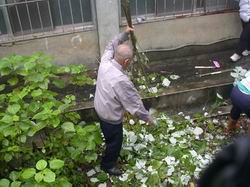 |
In the past, ramie was the major economic income for the traditional
tribe. For a family, the planting area represents the wealth of that family.
The fiber of ramie’s bark is soft and durable.
White in color, it is lustrous. Being the best in the flaxen family, it is
important material for the textile industry. |
|
Peel off the Ramie’s
Skin
| 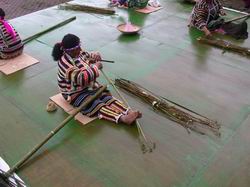 |
It is necessary to peel off ramie’s skin. With a tool made of bamboo,
people scratch away its skin and keep its fiber (white in color). In the past,
only women would do the job of peeling ramie’s skin. No man was allowed to
help.
|
|
Whipping
| 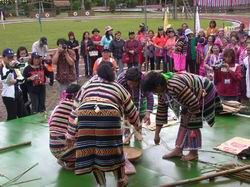 |
The fiber peeled off from the ramie is called ramie yarn. In order to
upgrade its quality, people have to whip the ramie on the rock to refine the
impure substances.
|
|
Drying under the Sun
|  |
After whipping the yarn, the ramie yarn will be tied up into bundles on
the stone and insolated under the sun in order to make it more tenacious and
dry its moisture so that it is more convenient for transportation.
|
|
Twisting
| 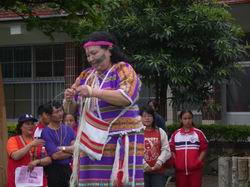 |
Holding one end of the ramie yarn with the incisors, people peel off the
ramie fibers with their hands. Then, they connect the yarn by twisting them
together. Rolling the yarn around the palms, people take off the yarn and tie
it in the middle. People call it “Bkuul.”
|
|
Rolling
| 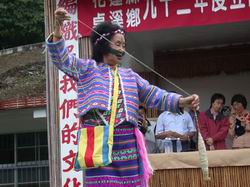 |
Using rolls (or yarn twisting rods), people will turn the rolls to make
the yarn revolve around the rolls until it is 10-20cm in diameter.
|
|
Spinning
| 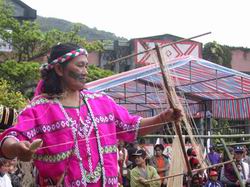 |
People use spindles to spin the yarn. After spinning, the yarn has to
undergo the following process: boiling, drying under the sun, dying, etc.
Undergoing these complicated processes, the ramie yarn will never become messy.
|
|
Boiling
| 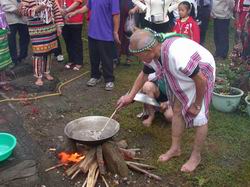 |
The ramie yarn will be mixed up with coal ashes. Then, they are put into
water. After stirring well, the yarn will be boiled and cooked for more than
three hours. If the ramie is clean, white, and soft, then the process is
completed.
|
|
Washing
| 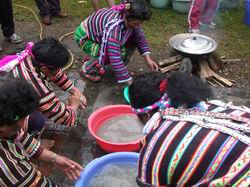 |
The dirt and mud on the yarn will be washed off. Then, the ramie yarn
will be cleaner and whiter.
|
|
Soaking
| 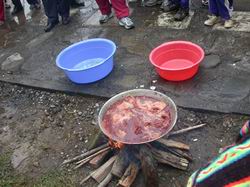 |
The ball roots of Dioscorea matsudae are dug from the field. Then, they
will be smashed and mixed with the ramie yarn. Soaking the ramie yarn in the Dioscorea
matsudae juice, the yarn will become red. There are many ways of soaking the
ramie yarn. One of them is soaking the ramie yarn in the juice of Lagerstroemia
subcostata Koehne. After soaking in the juice for a while, the ramie yarn will
become black.
|
|
Drying under the Sun
| 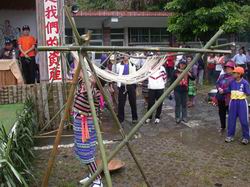 |
After soaking and washing, the ramie yarn will be put on the bamboo rack
and dried under the sun. The yarn will be left there and be exposed to the
weather, on both rainy and sunny days. It will be put there for one to two
weeks.
|
|
Combing
| 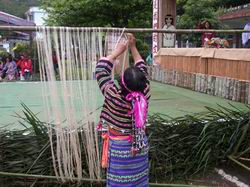 |
When drying the yarn under the sun, it is necessary to comb the yarn to
check if they are disjointed or twisted together. Therefore, the yarning
process is essential.
|
|
Warping
| 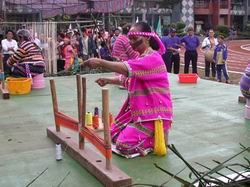 |
The yarn will be tied on the warp frame according to the pattern and
color desired. The effort put on the warp sorting frame will decide whether the
clothes are good or not.
|
|
Weaving
| 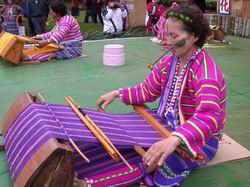 |
The are five kinds of patterns in weaving: plain, twill, rhombus, floral, rice, and float.
|
TOP
|
|
Common
Patterns
|
|
Patterns is a weaving method, with which people insert color woof lines to make
patterns (as shown in Ill. 1). However, it is not commonly seen in Truku style
clothes any more. On a white skirt, there will be the patterns shown in Ill. 2.
On the cloth woven nowadays,
the most common pattern is plain (as shown in Ill. 3-6).
|

|

|
|
Figure 1
|
Figure 2
|
 |

|
|
Figure 3
|
Figure 4
|
|

|

|
|
Figure 5
|
Figure 6
|
TOP
|
|
Textile
Products
|
|
In the past, Textile Products used by thick blankets and clothes. Now, the clothes are creative works
with diverse style.
|

|

|
|
Figure.
1 (Male Clothing)
|
Figure.
2 (Female Clothing)
|
|

|

|
|
Figure.
3 (Small Pillow)
|
Figure.
4 (Insulating Pad)
|
|

|

|
|
Figure.
5 (Backpack)
|
Figure.
6 (Tissue Box)
|
TOP
|
|

